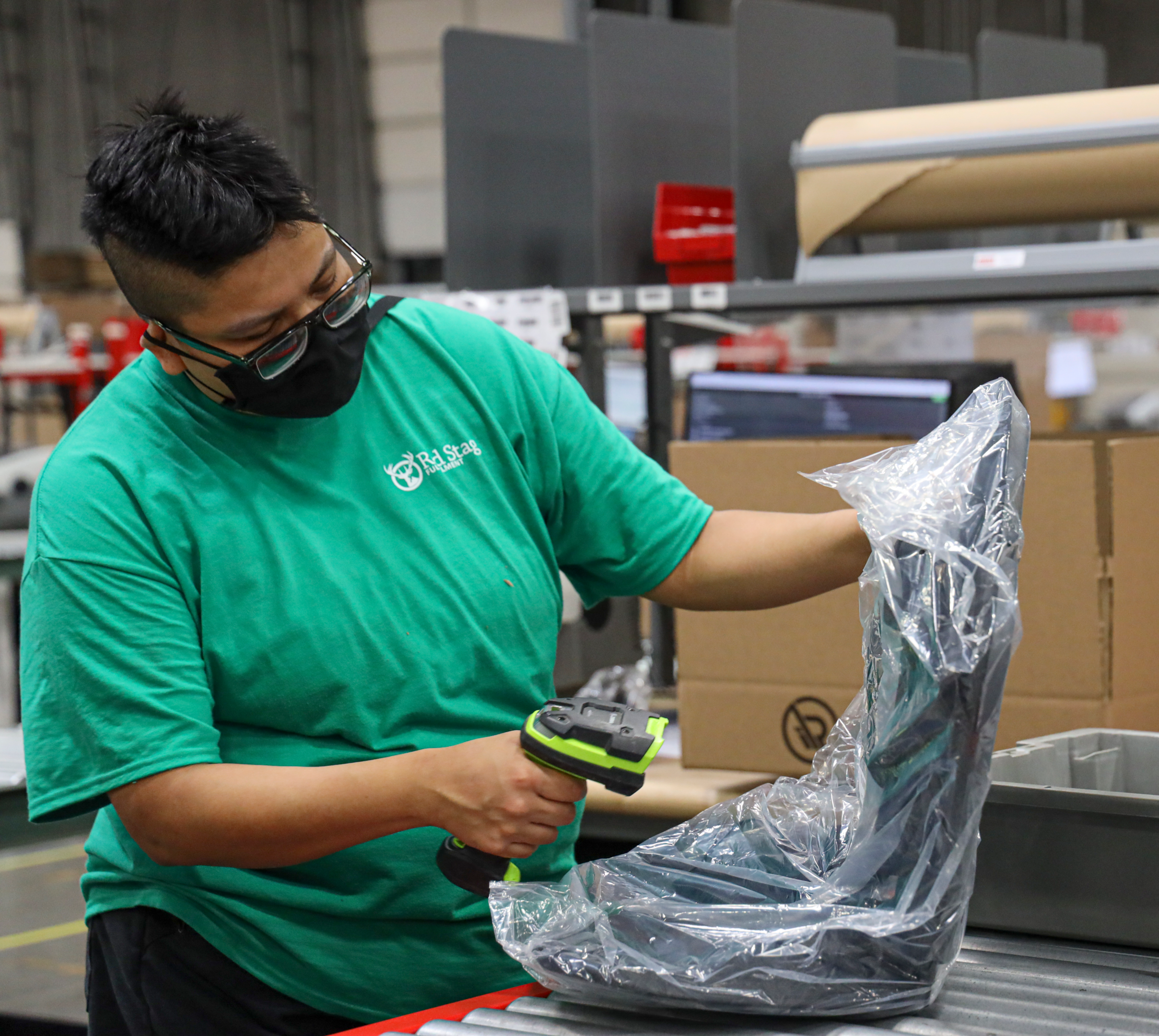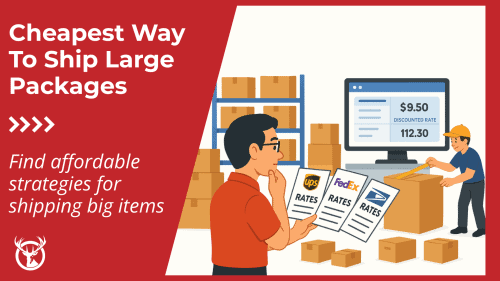Blind shipping can protect your brand image, streamline operations, and give you a competitive advantage.
At Red Stag Fulfillment, we’ve helped lots of ecommerce businesses leverage blind shipping to improve their customer experience and bottom line. But what is blind shipping?
In this article, we’ll explain what a blind shipment is, its advantages, and how to get started.

TL;DR:
Blind shipping explained

Blind shipping conceals supplier information from recipients, displaying only your branding on packages and documentation.

It protects supplier relationships and prevents customers from bypassing you to go directly to the source.

It enhances your brand experience through consistent packaging and professional presentation.

Successful implementation requires a reliable fulfillment partner with blind shipping expertise.
What is blind shipping?

Blind shipping is a shipping method where the supplier’s information is concealed from the recipient. Invoices and packaging display only the seller’s information and branding.
This is known as a blind bill of lading. It typically includes generic information, such as the product description, quantity, weight, and destination address.

Here’s how it works across various fulfillment options.

Traditional fulfillment: You store inventory at a fulfillment center or third-party logistics company (3PL). When an order comes in, the 3PL ships the product with your company’s information, ensuring your supplier remains hidden.

Drop shipping: A customer orders from your online store. You forward the order to your dropshipping supplier, who ships the product directly to the customer with your branding on the package.

Freight forwarding: A freight forwarding company may specialize in international shipping and have extensive networks and expertise in navigating customs regulations, tariffs, and other complexities associated with cross-border trade.
In all cases, the customer believes the product came straight from you. This can strengthen your brand and improve the customer experience.

PRO TIP: An e-bike company that sells batteries and motors sourced from external suppliers can use blind shipping to maintain their brand image. By partnering with a fulfillment center, all shipments display only the e-bike company’s information, preventing customers from seeking out suppliers directly and allowing the company to focus on design, sales, and marketing.
Benefits of blind shipping
Blind shipments offer a range of advantages for third-party sellers and businesses of all sizes. Take a look at the following benefits and see which ones might be helpful for your supply chain needs.

Protects your supplier relationships
Keeping supplier information private prevents customers from bypassing you and going directly to the product source. This safeguards your supply chain and the effort you put into building those partnerships.

Keeps you competitive
If you’re looking for a competitive advantage, blind shipping prevents rivals from easily identifying and potentially poaching your suppliers. It also makes price comparison harder for customers, encouraging loyalty to your brand.

Enhances your brand experience
With blind shipping, you control the entire customer unboxing experience. Consistent logo placement, custom packaging inserts, and reliable shipping times create a strong brand impression.

Streamlines operations
Blind shipping is especially valuable for drop-shippers. It eliminates the need to handle inventory yourself, saving on warehousing and shipping costs.

Expands customer options
Blind shipping can enable you to offer products or shipping options that might not be feasible if you were shipping everything yourself.
Drawbacks of blind shipping
Blind shipping offers compelling advantages, but it’s crucial to be aware of the potential challenges.
Reduced quality control
Since you don’t directly handle your products, ensuring consistent quality can be a concern. Thorough supplier vetting and regular quality checks are essential if you use a fulfillment center.

NOTE: Not all fulfillment centers offer blind shipping. Make sure your chosen partner has a proven track record with blind shipments and understands the process. Be sure to also ask about their inspections and how they handle defective products.
Longer shipping times and reduced flexibility
Relying on the wrong third-party logistics company can increase shipping times in some cases. This is especially true if suppliers and fulfillment centers aren’t geographically optimized.

NOTE: Check that your fulfillment center has strategically placed warehouse locations to ensure fast, efficient shipping across your target markets.
Potential for customer issues
If a customer has a problem with a product or shipment, resolving the issue may require more complex communication as you coordinate between your supplier and the customer. Having an efficient blind shipment return process can also minimize potential frustrations.

Key Takeaway: Clear communication between you, your supplier, and the fulfillment center is essential for smooth blind shipment operations. Establish protocols for handling customer service issues before they arise.
How to implement blind shipping
Implementing blind shipping successfully requires careful planning and collaboration with your fulfillment partner. Here’s a breakdown of the key steps.
Choose the right fulfillment partner
Consider the following criteria for finding a blind shipping company that meets your needs.

Blind shipping expertise: Ask prospective 3PL companies how long they’ve handled blind shipments, how many warehouses they have (and where they’re located), and how long the typical blind shipment takes.

Technology integration: Ideally, the fulfillment center’s system should integrate with your online store or website for seamless order processing and inventory management.

Communication: Look for a partner who values open communication and collaboration.
You might also discuss the following topics with your blind ship potential fulfillment partners.

Branding: Talk about your logo files, packaging specifications, and any desired marketing inserts (e.g., coupons, product samples).

Shipping expectations: Outline your preferred carriers, shipping speeds, and any special handling instructions.

Returns and customer service: Agree on returns processing, who covers return shipping costs, and how they will address customer inquiries.
Here’s what a proper return process might look like:
01
Prepare your products and packaging by removing supplier branding and considering custom packaging for an enhanced unboxing experience.
02
Develop a clear return and exchange policy, deciding whether to handle returns directly or route them to your fulfillment center.
03
Monitor performance by starting small, scheduling regular check-ins with your fulfillment partner, and tracking customer feedback.
Blind shipping legal considerations
While blind shipping offers many advantages, it’s important to be aware of the potential legal implications, especially regarding the following aspects.

ALERT: Even if you don’t directly manufacture a product, you might still bear some liability if it causes harm to a customer. Thorough supplier vetting, quality control processes, and product liability insurance are essential for mitigating your risk.
If you’re using blind shipping for customized products or rebranded products, make sure you have the proper agreements with your suppliers. This will help avoid potential intellectual property disputes.
It’s also advisable to consider the following.

Accurate documentation: While your branding should be front and center, customs paperwork and shipping labels must accurately identify the actual shipper (often your supplier or a fulfillment center) for import and export regulations.

Product safety and regulations: You are still responsible for ensuring the products you sell meet all relevant safety standards and adhere to any industry-specific regulations. Thoroughly vet your suppliers.

Country-specific restrictions: Certain products might be restricted or subject to additional duties when shipping internationally. Research regulations for your target markets.

NOTE: Laws and regulations regarding product liability and intellectual property can vary by jurisdiction. It’s strongly recommended to consult with an experienced legal professional. They can guide you on specific legal considerations relevant to your business, products, and target markets.
If you have any concerns about a specific product or market, it’s always best to consult with a legal professional for clarification.
Blind Shipping FAQ

What is a double blind shipment?
A double blind shipment takes the concept of blind shipping a step further. In this model, both the shipper and the receiver are unaware of each other’s identities. Double blind shipping is often used for added privacy or in industries where discretion is essential (like pharmaceuticals or sensitive intellectual property).
Setting up double blind shipping requires specialized logistics providers and is not recommended for most typical commerce situations.










How is blind shipping different from dropshipping?
Both blind shipping and dropshipping shield your supplier’s identity from the customer. The key difference lies in inventory ownership. With dropshipping, you never take possession of the products. In blind shipping, you can either store inventory with a fulfillment partner or have the supplier ship directly to the center for fulfillment.










What is a blind shipment fee?
A blind shipment fee is an additional charge levied by fulfillment centers or logistics providers to cover the extra steps involved in implementing blind shipping.
This might include removing original supplier branding, applying your custom branding, or handling additional communication between you, your supplier, and the fulfillment center.












